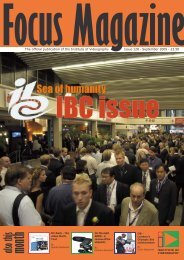IOV Executive Roles and Responsibilities
IOV Executive Roles and Responsibilities
IOV Executive Roles and Responsibilities
You also want an ePaper? Increase the reach of your titles
YUMPU automatically turns print PDFs into web optimized ePapers that Google loves.
<strong>IOV</strong> <strong>Executive</strong> <strong>Roles</strong> <strong>and</strong> <strong>Responsibilities</strong>IntroductionThe <strong>Executive</strong> Committee are elected by the membership to manage the interests of the <strong>IOV</strong>; todeal with any sub-contractors <strong>and</strong> professional contractors; to ensure the <strong>IOV</strong>’s constitution ismaintained <strong>and</strong> amended accordingly; to deal with arbitration <strong>and</strong> disciplinary matters; <strong>and</strong> toensure that the <strong>IOV</strong> continues to represent the interests of its members at all times.In practical terms, serving on the <strong>Executive</strong> includes being able to attend at least 5 proper<strong>Executive</strong> meetings each year. These are mainly held in the UK - but with flights as cheap as theyare it could be anywhere in Euro-Zone. Whilst it's not a completely voluntary position - with ahealthy meeting allowance paid <strong>and</strong> travel expenses reimbursed - there is much work done outsideof these formal meetings which is purely voluntary.Any c<strong>and</strong>idate must be able to respond regularly to communications by email <strong>and</strong> phone - not onlywith their other <strong>Executive</strong> members, but also with members within their region <strong>and</strong> areas ofresponsibility. C<strong>and</strong>idates must be familiar with email <strong>and</strong> internet technology, <strong>and</strong> also in officeapplications such as merging data with correspondence - have organisational skills in setting uplocal events - <strong>and</strong> the enthusiasm <strong>and</strong> drive to develop the membership.Above all, c<strong>and</strong>idates must be able to represent the views <strong>and</strong> interests of the members at<strong>Executive</strong> meetings - but at the same time reflect <strong>and</strong> support the collective view of the <strong>Executive</strong>Committee to the membership. Being a democratic body, the collective view of the <strong>Executive</strong> mustalways come before the individual views or desires for the <strong>IOV</strong> of the individual <strong>Executive</strong> member.Appointment of an <strong>Executive</strong> Committee MemberAppointment to the <strong>Executive</strong> is governed by the <strong>IOV</strong>’s Constitution. This currently dictates thatany qualified member who has been a member for a continuous period of 5-years is eligible to benominated for election to the <strong>Executive</strong> Committee. They must be nominated by another member.If there are the same number of vacant positions as there are proposed c<strong>and</strong>idates at the time ofcommittee elections, those c<strong>and</strong>idates will be appointed unopposed. In the event of there being afull <strong>Executive</strong> (currently 7 members – though this is determined by the workload <strong>and</strong> decided bythe committee), any new nominees <strong>and</strong> any existing committee members who are offeringthemselves for re-election will be entered onto a ballot paper <strong>and</strong> the membership will then voteon who they want to serve on the <strong>Executive</strong>. Those c<strong>and</strong>idates who attract the greatest number ofvotes will be appointed to the committee.In addition to those that offer themselves for election to the committee, the <strong>Executive</strong> also havethe power to co-opt members (regardless of qualification status) to the committee if they believetheir contribution would add value to the <strong>IOV</strong>. These co-opted <strong>Executive</strong> members will be put upfor formal election at the next available AGM. This situation might occur if the committee numberfalls below 7 mid-term.Retirement or Removal of <strong>Executive</strong> Committee MembersEach year 1/3 of the <strong>Executive</strong> Committee retires by rotation – <strong>and</strong> can offer themselves for reelectionif they so wish.The <strong>Executive</strong> Committee has the power to remove any committee member from the <strong>Executive</strong>.This is covered under Item 37 – part ‘f’ of the Articles of Association – “his membership of theInstitute is terminated by the <strong>Executive</strong> Committee pursuant to Article 4.” Item 4 empowers the<strong>Executive</strong> to terminate the membership of any member – however the requirements of naturaljustice shall be respected <strong>and</strong> a member shall be entitled to be heard in his own defence by the<strong>Executive</strong> Committee or a member of the <strong>Executive</strong> Committee.1
What constitutes a proper <strong>Executive</strong> Meeting?Any meeting which is officially organised <strong>and</strong> minuted. This can be an extraordinary meetingwhich is arranged at short notice, but which is deemed to be a proper <strong>Executive</strong> meeting by amajority of the <strong>Executive</strong>.Who presides over the <strong>Executive</strong> meeting?The current chairperson shall govern the proceedings at the <strong>Executive</strong> meetings, <strong>and</strong> shall have acasting vote in situations where there is a hung decision. In the absence of the chairperson, thevice-chairperson shall fulfil the chairperson’s responsibility.What is paid to <strong>Executive</strong> Members for attending meetings?For attending a proper meeting, <strong>Executive</strong> members shall be paid a fee for each meeting – thelevel of which is set each year by the <strong>Executive</strong> Committee. Any remuneration over <strong>and</strong> abovethis, or any payment for special meetings outside of the scope of the proper <strong>Executive</strong> Committeemeetings, shall be by prior arrangement with the chairperson <strong>and</strong> a majority of the <strong>Executive</strong>Committee.In addition, any out of pocket expenses incurred in travelling to the meeting shall be paid, subjectto the completion of an official expenses claim form. Any expenses over <strong>and</strong> above those incurredat proper <strong>Executive</strong> meetings shall be made by pre-arrangement only- <strong>and</strong> in strict accordancewith the guidance notes on claiming expenses.In addition to the allowance paid for proper meetings, the <strong>Executive</strong> has the right to assign specificroles within the <strong>IOV</strong>, <strong>and</strong> to allocate funds to support these activities by way of retainers or one-offpayments. An example of this would be the Treasurer, the Arbitration Officer, the AssessmentAdministrator – <strong>and</strong> others carrying out contract work such as the preparation of the AwardsShowreel DVD. These roles, <strong>and</strong> the fee for them, are discussed by the <strong>Executive</strong> Committee atone of their proper meetings each year.ENDS.2
















